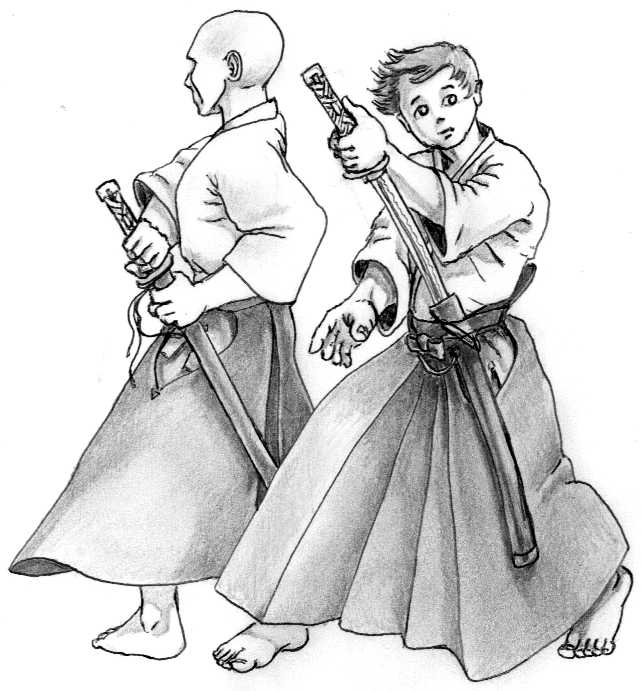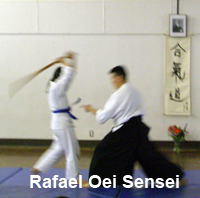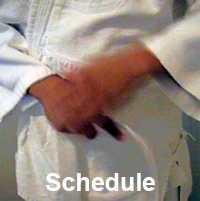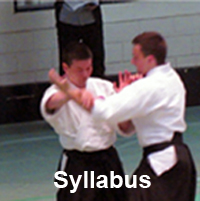DOJO ETIQUETTE
Rules During Practice (by O Sensei) |
1. One blow in Aikido can kill. In practice, obey your instructor, do not compete, nor test each other's strength.
2. Aikido trains you to face more than one opponent. Therefore concentrate, polish, and perfect each movement so you may take an approaching force from any direction.
3. Always practice in high spirits.
4. The teachings of your instructor constitute a fraction of what you will learn. The rest of the path depends on individual effort and sincere practice.
5. Daily practice begins with light movements gradually increasing in intensity; but there must not be over-exertion. The very nature of Aikido enables even an elderly person to practice with pleasure without harm. In this way, you will attain the goal of your training.
6. Aikido trains the body and the mind; cultivating integrity, sincerity, and harmony with all things. Aikido is noble in nature and should not be abused nor practiced in public indiscriminately.
Students are responsible for their own cleanliness, and of their Dogi (doe-ghee / uniform). Wash your Dogi after class, if possible.
Finger nails and toe nails must be clean and trimmed at all times.
Long and unruly hair must be tied up. Hands and feet must be washed and wiped dry before entering the dojo.
If unwell, a student may be excused from training. Please inform the instructor.
If the ailment is not contagious, a student may observe the class. Permission from the instructor must first be granted.
Students shall not put on jewellery, bangles, or watches during training.
Consumption of food and drink in the dojo and during class is not permitted.
When visiting a dojo, seek permission from the instructor-in-charge before changing into your Dogi for practice. If a letter of introduction is to be presented, arrive at least 15 minutes ahead of time.
Quietly observe the dojo's senior students to get an idea of and adapt to the culture of that dojo.
Footwear must be placed in an orderly fashion or on shoe racks before entering the dojo. Bags and personal belongings must be neatly stored outside of the mat aread, or in lockers if available/provided.
Spend the time, while waiting to enter the dojo, in mental preparation for the class - not in idle chatter. Help to clean the dojo if necessasry.
Warm-up stretches should only be done during the class and not in the hallway or side of the mats.
Students shall not demonstrate techniques on each other in the hallway or in public.
Give and receive with both hands, palm upwards. The tradition behind this is to show you have nothing concealed / hidden - especially weapons - and that you are giving and receiving with a sincere heart.
Upon entering the dojo, and onto the mats, bow once to the Kamiza. The formal seated bow is preferred.
One more bow to the dojo in general, and to students already on the mat may then be performed as a greeting and sign of respect.
If a student is late, sit quietly in seiza off the mat and to the side. Make eye-contact with the instructor, raise your hand and wait to be permitted to enter onto the mat.
Students are not permitted to walk or run across the training area at all times.
While on the mat and waiting for the class to begin, sit quietly in seiza in rank and file. This time may be used to focus and prepare for the lesson ahead.
After the ceremonial bow that begins the class, bow to the student next to you with a polite "onegaishimasu" to pair up for practice.
Students will not leave the mat without permission.
Bow to your partner once before, and once after practising each technique.
When the instructor stops you to explain a technique, sit in seiza to listen and observe. Bow in gratitude to acknowledge the explanation.
New students should observe senior students for proper behaviour in and around the dojo.
After practicing, thank your partner with a bow and a "domo arigatougozaimashita".
Bow and express gratitude to everyone you practised with during the class.
Help to return weapons to their racks and clean the dojo, if necessary.
Bow to the Kamiza and dojo as before, and leave the training area silently. Do not loiter on the mats.

Respect for Senseis
Upon seeing an approaching sensei, regardless of dojo or martial art affiliation, the respectful observance would be to acknowledge and greet the sensei with a bow and appropriate greeting. The traditional practice is to meet the approaching sensei halfway, and not to ignore or pretend not see them. If seated, it would be respectful to stand to greet the approaching sensei to acknowledge their presence.
Junior ranks should offer to carry the sensei's bag. If the sensei declines, respectfully step aside to allow the sensei to pass. When carrying a sensei's bag or walking with a sensei, it is traditional to follow behind and to the left of the sensei. The tradition behind this comes from the samurai protecting the master's left side, as swords are normally worn on the left and drawn with the right hand - leaving the left side unprotected. The task of protecting the left side would then fall on his samurai (disciple) walking just behind the master, and to his left.
When walking in a group, trail slightly behind the sensei as they walk ahead.
Respect for all aikido members and senseis regardless of nationality, race, religion, or creed should be consistent and sincere. This reveals character and integrity in the practitioner.
Please be aware that students with dan grade black belts are not automatically conferred the title "sensei", assistant, or "deshi" upon receiving the dan grade. Individual students are selected to embark on this long journey of apprenticeship by their own sensei - sometimes as early as the student's first day of training. The title "sensei" or "shidoin" is normally conferred to the candidate at the 4th dan level.
To one day be responsible for sharing the teachings of Aikido, and to inturn select and groom capable students to assume the responsibilities of a sensei is not a mission to be taken lightly. As such, the respect shown to senseis is not a frivolous one, nor an exercise in boosting the ego. It is respect due and accorded to those who bear the responsibility of the station, to pass on the teachings and traditions of Aikido.
Webpages & Illustrations by Rafael Oei Victoria, BC, Canada
Updated: 25-Feb-2024te -->




